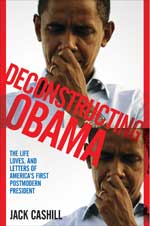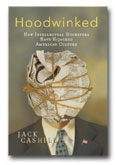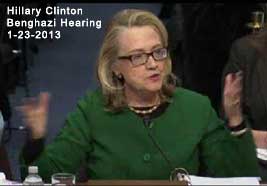Digging the Benghazi Memory Hole
Get your copy of Deconstructing Obama

___
Jack Cashill's book:
Hoodwinked: How Intellectual Hucksters have Hijacked American Culture

Click here for signed first edition
©Jack Cashill
AmericanThinker.com - January 24, 2013
With Wednesday’s hearing, Hillary Clinton played her uniquely dramatic role in the one shovel-ready project in Obama’s America--the Benghazi memory hole. She spent the day burying the whole sordid Benghazi mess. Don’t expect the media to exhume it. They have already started chastising those who try.
 The reader may think it impossible for Ms. Clinton to forget an incident in which she embraced “the mothers and fathers, sisters and brothers, sons and daughters” of the Benghazi dead, not to mention “the wives left alone to raise their children." Indeed, the very memory of this moment caused her to tear up during the hearing.
The reader may think it impossible for Ms. Clinton to forget an incident in which she embraced “the mothers and fathers, sisters and brothers, sons and daughters” of the Benghazi dead, not to mention “the wives left alone to raise their children." Indeed, the very memory of this moment caused her to tear up during the hearing.
But this was not her first memory hole, nor even her biggest. On the night of July 17, 1996, she stayed up well past her bedtime to start digging the mother of all memory holes. As her official schedule attests, she and President Clinton attended a gala for the Women’s Leadership Forum of the DNC at the Sheraton Washington Hotel that evening. At 8:35 p.m. she and Bill left the Sheraton by presidential motorcade and headed back to the White House.
At 8:31 p.m., however, a few hundred miles away, two FAA veterans at the New York Air Route Traffic Control Center observed a target arching and intersecting with TWA Flight 800 as it headed east off Long Island’s south shore.
By 9 p.m., Clinton’s anti-terror czar, Richard Clarke, was driving in to the White House to convene an emergency meeting of his security group to address the disaster.
"I dreaded what I thought was about to happen," Clarke wrote in his memoir, Against All Enemies, "The Eisenhower option." Had Iran been behind the downing of TWA Flight 800, the president would have had to respond. Nearly three weeks later, Clinton was telling historian Taylor Branch that Iran was almost assuredly behind this seeming missile attack. “They want war,” Branch recorded Clinton as saying.
This had to have been a harrowing time for Hillary. She was holed up that first night in the family quarters with Bill and White House fixer Sandy Berger. A week later, she flew with Bill to Long Island to console the families of the 230 victims. Clarke went with them. He talked about the Clintons "praying with [the families], hugging them, taking pictures with them” and then seeing "Mrs. Clinton" alone in a makeshift chapel, praying "on her knees."
Eight years later, Hillary wrote about this turbulent time in her 500-plus-page memoir, Living History. To this extraordinary incident, one that Clarke called "The Almost War, 1996," she dedicated exactly one-third of a sentence. That’s it. Not to be outdone, in his 900-plus-page memoir, My Life, Bill Clinton dedicated just one paragraph. He wrote more words about a June 1996 day in Albuquerque where he discussed that community’s curfew program than he did about that July night a month later when 230 people were killed and the nation almost went to war.
The Clintons could safely stuff this tragedy down the memory hole because they were confident their accomplices would do the same. In his memoir, My FBI: Bringing Down The Mafia, Investigating Bill Clinton, and Fighting the War on Terror, former FBI director Louis Freeh gave the tragedy two sentences: “Three weeks later. On July 17, TWA flight 800 exploded off Long Island minutes after taking off from John F. Kennedy International Airport. No one knew what brought it down: mechanical failure, a bomb, a ground-to-air missile all seemed possible in the early stages.” That’s it. Despite the fact that this highly controversial investigation involved hundreds of FBI agents full time for months and some agents for years, Freeh could only spare it a tweet.
In July 1996, former CIA Director George Tenet served as Deputy Director of Central Intelligence. In his memoir, At the Center of the Storm, he wrote about a 1995 National Intelligence Estimate, which highlighted civil aviation as a target for radical Islamists, and a 1997 one that made the same point even more forcefully. Yet so powerful was the gravitational field of the TWA 800 memory hole that not even a single proton of information about the doomed flight escaped it into Tenet’s book—not a word.
In his memoir, Off With Their Heads, presidential advisor Dick Morris referred to TWA 800 as one of “three attacks" in the "terror summer of 1996." “Americans demanded action,” Morris wrote of the three attacks. “But all they got were speeches.” About two of the attacks, Khobar Towers and the Olympic Park bombing, Morris has been forthcoming. About TWA Flight 800 he has been silent beyond its mere mention. A few years back, Morris and I were both on Paul Schiffer's Cleveland-area radio show at the same time. Three times I asked him to elaborate on the TWA Flight 800 crash. Three times he absolutely evaded the question.
On Sept. 11 2001, George Stephanopoulos, former assistant to President Clinton, talked with Peter Jennings on ABC TV about how the president would use the White House "situation room" to communicate with key staff in the wake of an attack. Said Stephanopoulos: “In my time at the White House [the situation room] was used in the aftermath of the Oklahoma City bombing, in the aftermath of the TWA Flight 800 bombing, and that would be the way they would stay in contact through the afternoon.” In his memoir Only Human, Stephanopoulos did not mention a single word about TWA Flight 800, let alone what he knew about the “bombing” of the same.
Once upon a time, we could rely on the media to tell us what the political insiders wouldn’t. Remember Watergate? Today, the insiders are the media.
Don’t hold your breath about Benghazi.
Webmaster's Note: Jack Cashill's Book-TV presentation of "Deconstructing Obama" can be viewed at http://www.c-spanvideo.org/program/298382-1
Editor's note: For a more complete account of this phenomenon, read Jack Cashill's amazing book, "Hoodwinked: How Intellectual Hucksters Have Hijacked American Culture.

